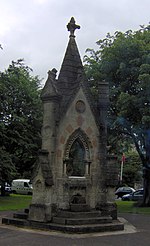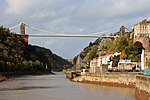Hotwells Halt railway station
Bristol Port Railway and PierDisused railway stations in BristolFormer Great Western Railway stationsPages with no open date in Infobox stationRailway stations in Great Britain closed in 1922 ... and 2 more
Railway stations in Great Britain opened in 1917Use British English from May 2017

Hotwells Halt railway station, also known as the Hotwells Extension Platform, was a railway station situated in the suburb of Hotwells in Bristol, England. It was on the Bristol Port Railway and Pier line which ran between Avonmouth and Hotwells. The station opened in 1917, and closed in 1922.
Excerpt from the Wikipedia article Hotwells Halt railway station (License: CC BY-SA 3.0, Authors, Images).Hotwells Halt railway station
Bridge Valley Road, Bristol Clifton
Geographical coordinates (GPS) Address Nearby Places Show on map
Geographical coordinates (GPS)
| Latitude | Longitude |
|---|---|
| N 51.46 ° | E -2.629 ° |
Address
Bridge Valley Road
Bridge Valley Road
BS8 3HT Bristol, Clifton
England, United Kingdom
Open on Google Maps









